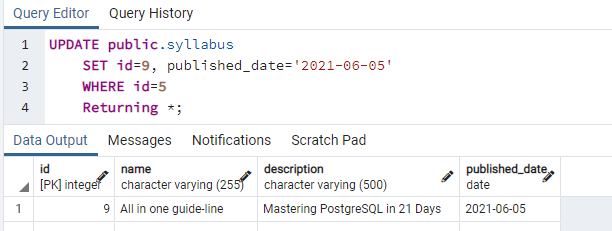

We hope you learned how to do the ON DELETE CASCADE operation in PostgreSQL. This will guarantee the security and safety of your database and avoid problems in the future. If you want to CASCADE, call a function for DELETE, then make a TRANSACTION and constantly check for mishappenings rather than at the end. If you do not have the ON UPDATE CASCADE constraint, then you will need create scripts to complete the update. This will create an issue but rolling back to any changes will be highly unlikely.Īlways make sure to use good practices for DELETE. If you have defined the Foreign Key constraints as ON UPDATE CASCADE then the Primary Key value that was changed should cascade down to all the Foreign Keys with that constraint. a Short Note on the Issues Faced on Defining Multiple ON CASCADE DELETE Constraints in PostgreSQLĪn ON DELETE CASCADE put on all the inheriting tables will make an issue when you delete a row that references thousands of tables. You can even use these options for the ON UPDATE operation in other ways. In that case, you can try changing the ON DELETE CASCADE to ON DELETE RESTRICT, which will eventually restrict any DELETE operations that come into conflict. This time, specifying those ON DELETE CASCADE ON UPDATE. save-update cascade indicates that when an object is placed into a Session via Session.add (), all the objects associated with it via this relationship () should also be added to that same Session. Suppose you are better off with the original and want to define your method. Next, we can reuse that same FOREIGN KEY constraint name again, in a follow-up ALTER TABLE command. Why? Because CASCADE tends to drop the row proposed for DELETE in the child table. Now when we try to DELETE, it works perfectly. When a foreign key is created with ON DELETE CASCADE or ON UPDATE CASCADE, then on delete or update of a referenced row in the parent table, the foreign key row of referencing row in the child table will be automatically deleted.Create table bus ( id int PRIMARY KEY references vehicle ON DELETE CASCADE, Model TEXT )

The dept_id 3 must exist in the department table otherwise, an error will be raised.įor example, if you specify 4 as the default value of dept_id in the employee table then trying to delete a row in the department table would raise an error, as shown below. However when looking are the SQL in Postgresql its created. If no default value is specified for dept_id in the employee table, then the above deletion will set the value as NULL. I want it to keep the Person entries when deleted but if a group is deleted in needs to cascade. Note that there is default value 3 specified in the employee table for the dept_id column. Let's check the data in the employee table. In Postgres (and other RDBMs) cascading updates apply exclusively to foreign keys.

FOREIGN KEY (projectid) REFERENCES projects(id) ON DELETE CASCADE. We defined foreign key constraint with ON DELETE SET DEFAULT, so referencing row with emp_id = 1 in employee table whose dept_id was 1 is now set to DEFAULT value which is 3. In relational databases (including PostgreSQL), foreign keys provide a way to link. The following example demonstrates the NO ACTION referential action.ĭELETE FROM department WHERE dept_id = 1 Īs you can see, it allowed deletion of the department. The NO ACTION produces an error indicating that the deletion or update would create a foreign key constraint violation. The NO ACTION referential action is the default action if ON DELETE or ON UPDATE clause is not specified. NO ACTION – Raise an Error on Delete or Update

Note: The foreign key column name does not need to be the same as a primary key column, but it's advisable to do so for readability purposes. So, it will consider the default NO ACTION. Notice that we did not define any action such as ON DELETE or ON UPDATE clause. The above foreign key established a one-to-many relation between department and employee table where a department can have zero or more employees, and one employee cannot have more than one department. The CONSTRAINT FK_employee_department specifies the foreign key name FK_employee_department, FOREIGN KEY(dept_id) specifies the foreign key column in the employee table,Īnd REFERENCES department(dept_id) specifies that the foreign key column refers to the dept_id column of the department table. In the above example, the dept_id column in the employee table is defined as a foreign key column that references the primary key column dept_id of the department table.


 0 kommentar(er)
0 kommentar(er)
